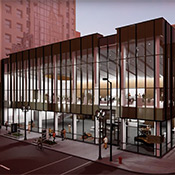
Bradley Symphony Center December Update
David Lewellen
PUBLISHED
Tagged Under: 2020.21 Season, Bradley Symphony Center, MSO Notable
The original plan was that by now, the Milwaukee Symphony would be more than a month into playing classical and pops concerts in the beautifully restored Bradley Symphony Center, and decorating for the holiday season would be up next.
But this is 2020, and nothing happens according to the original plan. The pandemic has kept the symphony from performing live and in person for nearly nine months. And on top of that, flooding in the lower level in May caused severe electrical damage and put the entire project behind schedule. But with occupancy permits set for December, the hall is close to ready.
“I notice new details every time I’m in here,” said John Roloff, the symphony’s point person for the construction project, who is in the hall more than almost anyone who’s not actually building it.
On a recent Friday, workers were installing seats in the balcony, and stacks of shrink-wrapped boxes on the main floor held more seats waiting to go in. The stage is basically finished. Behind the orchestra, a balcony on three sides will seat the chorus (or audience members, for concerts that don’t include a chorus), and vents higher in the wall will welcome an organ in some future season. Doors and vents directly underneath the chorus seats will help fine-tune the acoustics of the hall for individual pieces; so will heavy drapes at the back of the hall that can be pulled out for amplified concerts and put away for acoustic concerts.
Classical concerts are typically performed without amplification, but pops concerts are another matter – and the Bradley Symphony Center will be available to other acts on nights when the MSO doesn’t perform. The symphony has a good relationship with the Pabst-Riverside ownership group, and Roloff said the new hall would be a good fit for bands that draw a bigger crowd than the Pabst but a smaller crowd than the Riverside.
Fine-tuning the acoustics of the hall involves an extra degree of difficulty during the pandemic, since the orchestra can’t assemble for a sound check. “Mahler and social distancing don’t agree,” Roloff said, referring to the great Austrian composer who typically wrote for very large ensembles. But as the recently announced, pandemic-conscious season progresses next spring, going from small ensembles in January to a Beethoven symphony in June, acousticians will be in the hall making adjustments.
The stage can seat 100 musicians, enough for all but the most gargantuan pieces in the repertoire, but the fit will be snugger than it was at the Marcus Center. But “because we had so much space on the Marcus Center stage, musicians tended to spread out,” said Roloff, the symphony’s senior director of orchestra and facility operations. “And some of them say that wasn’t good for ensemble.”
The brand-new interior walls behind the orchestra are in a style consistent with the rest of the theater, but not nearly as elaborate as the decorations that burst from almost every surface of the hall and the original lobby space. “It’s just meant to complement the space,” Roloff said. “Behind the proscenium, the art is what happens onstage.”
The new portions of the building, on the south and north sides of the original theater, have many new restrooms (more stalls for women than men, and several gender-neutral facilities), but on the second floor, the original restrooms, complete with green and lavender tiles, will be preserved, with new plumbing. The lounge rooms with fireplaces outside the restrooms are restored too, “just like it was back in the day,” Roloff said, “except there won’t be smoking.” Exit signs in an Art Deco typeface are also original to the building.
The Atrium is not quite complete, but the spiral staircase, and the enormous oculus skylight with the view of the Richard Haas mural above it, are in place. So is the glass wall fronting on Wisconsin Avenue and Second Street, subtly inscribed with the names of hundreds of composers whose works the MSO has performed over the decades. The wood panels, of a color to evoke string instruments, have been installed; brass accents, and black and white marble reminiscent of piano keys, will be coming soon.
As well as mingling before concerts, the new space can also host sit-down dinners and other events; so can the soaring three-story historic lobby directly off Wisconsin Avenue. “The detail and craftsmanship goes all the way to the ceiling,” Roloff said – but now that the scaffolding has been taken down, visitors will have to crane their necks to get a look. The restoration experts from Conrad Schmitt Studios of New Berlin “cleaned away years of dirt and dust and nicotine,” but very little actual repair work was necessary. “It’s amazing that it sat so long,” Roloff said. “There’s something to take in at every turn.”



